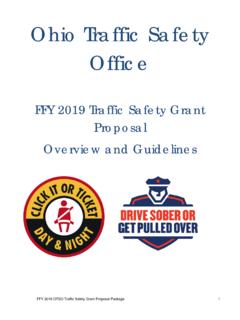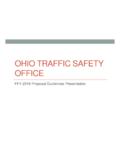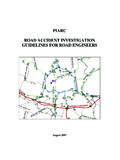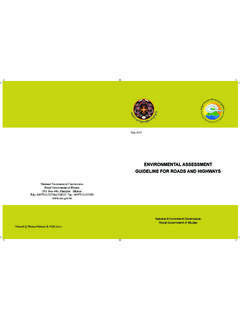Transcription of v01-19-11 Life Cycle Cost Analysis (LCCA)
1 1 v01-19- 11 life cycle cost analysis (LCCA) Introduction The SHRP2 R-23 guidelines provide a number of possible alternative designs using either rigid of flexible pavements. There is usually not a single design that meets the design criteria but a number of alternative designs that can be considered as viable solutions. The method of selecting the best possible approach may consist of an economic evaluation, a decision matrix, or a combination of those approaches. There are several types of economic or criteria based evaluations that can be carried out as part of conducting a life Cycle cost Analysis (LCCA): cost -benefit Analysis , cost -effectiveness Analysis , multi-criteria Analysis , risk-benefit Analysis , etc.
2 At one extreme lies the purely multi-criteria Analysis , which employs weights from a variety of sources that contain a large degree of subjective assessment. At the other extreme lies the purely cost -benefit Analysis that exclusively employs monetary valuation and has generally more explicitly defined criteria. Most Highway Agencies have established some form of selection process and it is expected that those Agencies will apply those to select between different options. For those Agencies who do not have a formal selection procedure in place, the following guidance for conducting life Cycle cost Analysis is provided and recommended to aid the selection process. LCCA Procedure Most agree that life - Cycle cost Analysis can be carried out using a few standardized steps.
3 The process of a typical LCCA can be divided into the following: Establish strategies for a 50-year service period. Establish activity timing. Estimate agency costs. Estimate user costs. Develop expenditure streams. Compute net present value (NPV). Conduct risk Analysis . Reevaluate strategies. These steps will be explained more fully in the content that follows. Establish Strategies for a 50 year Service Period The primary purpose of an LCCA is to quantify the implications of initial pavement design decisions regarding the future costs of maintenance and rehabilitation activities over 50 years. This assumes that a high level of service is maintained to preclude the use of full depth patching and other major repairs.
4 Having a clear picture of the performance of the pavement over that period is critical to the selection of the most cost efficient alternative for that particular location and project. The timing of 2 needed minor repairs, which if properly managed, will efficiently preserve the pavement condition over the 50 year design period at what would be expected to be the lower total cost . It is anticipated a 50-year Analysis period will be long enough to incorporate multiple rehabilitation activities repeated through the service period. Figure 1 shows a typical Analysis period for a given pavement design alternative. guidelines for the preservation of long life pavements is included in these guidelines based on the work performed in SHRP 2 Project R-26 "Preservation Approaches for High Traffic Volume Roadways.
5 " Preservation treatments and approaches recommended in those guidelines should be considered in the re-accruing maintenance or preservation costs associated with each design alternative. A simplified illustration of the activity and timing is illustrated in Figure 1. Figure 1. Example of Pavement Performance life (WSDOT, 2010) Typically, each design alternative will have an expected initial design life , periodic maintenance treatments and rehabilitation. In terms of the LCCA, it is important to identify the developing distress condition, timing, and cost of the key activities. SHAs have historically planned to employ a variety of rehabilitation strategies to keep highway facilities in a functional condition.
6 For example, Table 1 shows the Washington State Department of Transportation's (WSDOT) maintenance and rehabilitation framework representing a conventional approach to maintain new and reconstructed pavements over a 50 year period in their LCCA procedure (WSDOT Pavement Guide Volume 1 2009). 3 Table 1. Rehabilitation Scenarios for HMA and PCC Pavements Year HMA Pavement PCC Pavement 0 Construction or reconstruction Construction or reconstruction 15 in. mill and HMA overlay 20 Diamond grinding 30 in. HMA overlay 40 Diamond grinding 45 in. mill and HMA overlay 50 Salvage value (if applicable) Salvage value (if applicable) Establish Activity Timing Performance life for the initial pavement design and subsequent rehabilitation activities has a major impact on LCCA results.
7 It directly affects the frequency of agency intervention on the highway facility, which in turn affects agency cost as well as user costs during maintenance activities. State Highway Agencies (SHAs) can determine specific performance information for various pavement strategies through Analysis of pavement management data and historical experience as a basis of calibration of performance-related models and tools. Operational pavement management systems can provide the data to evaluate pavement condition and performance to identify performance trends. Current FHWA efforts to analyze pavement performance data collected as part of the Long-Term Pavement Performance Program (LTPP) should provide an additional valuable resource to SHAs.
8 Work zone requirements for initial construction, maintenance, and rehabilitation directly affect highway user costs and should be estimated along with pavement strategy development. The frequency, duration, severity, and year of work zone requirement are critical factors in developing user costs for the alternatives being considered. Estimate Agency Costs Construction quantities and costs are directly related to the initial design and subsequent rehabilitation strategy. The first step in estimating agency costs is to determine construction quantities/unit prices. Unit prices can be determined from SHA historical data on previously bid jobs of comparable scale. Other data sources include the Bid Analysis Management System, if used by the SHA.
9 LCCA comparisons are always made between mutually exclusive competing alternatives only reflecting differential costs between alternatives. In other words, costs that are common to all alternatives will simply cancel each other out in the LCCA calculations. In the past many agencies did not include traffic control costs since they were relatively common to different approaches for new construction. The existing, high volume highway facilities considered in 4 these guidelines , traffic management costs may be a large part of the total costs and significantly different between alternative designs. Traffic management costs should be considered in comparing alternative design costs.
10 Agency costs include all costs incurred directly by the agency over the life of the project. They typically include initial preliminary engineering, contract administration, construction supervision and construction cost , and the associated condition monitoring cost . Routine or preservative maintenance must be proactively rather than reactively applied in order to be effective in preserving the condition of the pavement. Even though, routine preservative-type maintenance costs are generally not excessively high, their role in maintaining a relatively high performance level cannot be over stated. Unfortunately, many SHAs may not have tracked routine maintenance timing or costs providing little data regarding the differences between most alternative pavement strategies.








